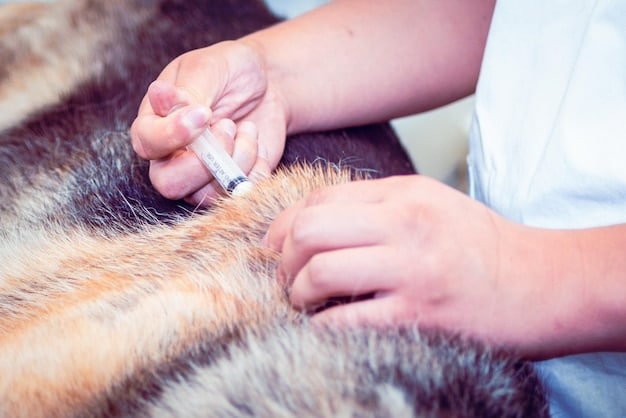Microchipping: Ensuring Swift Reunions for Lost Pets in the US

Microchipping is crucial for pet owners in the US, as it dramatically increases the likelihood of reuniting quickly with a lost pet, often within 24 hours, by providing a permanent identification linked to the owner’s contact information.
Losing a pet can be a heart-wrenching experience for any owner in the US. The fear, the frantic searching, and the uncertainty can be overwhelming. But what if there was a simple, effective way to significantly increase the chances of a swift reunion? That’s where microchipping comes in, offering a beacon of hope for lost pets and their worried families, often reuniting them within 24 hours.
Understanding the Power of Microchipping
Microchipping is a simple yet powerful procedure that can make all the difference in bringing a lost pet back home. It’s about more than just identification; it’s about peace of mind.
A microchip is a small, electronic chip, about the size of a grain of rice, that is implanted under the pet’s skin, usually between the shoulder blades. This chip contains a unique identification number that is linked to a registry with the pet owner’s contact information. When a lost pet is found and scanned by a veterinarian or animal shelter, the microchip number is revealed, allowing them to quickly access the owner’s details and facilitate a reunion.
How Microchipping Works
The process of microchipping is quick and relatively painless. It’s similar to receiving a routine vaccination.
Why Collars and Tags Aren’t Enough
While collars and tags are helpful, they can be easily lost or removed. A microchip provides a permanent and reliable form of identification.
- Permanent Identification: Microchips cannot be easily lost or removed.
- Reliable Contact Information: Contact information is securely stored in a registry.
- Increased Reunion Rates: Microchipped pets have a significantly higher chance of being returned home.
- Peace of Mind: Knowing your pet has a permanent form of identification provides peace of mind.
In essence, microchipping is a proactive step that every responsible pet owner should consider. It’s a small investment that can yield immeasurable returns in the event of a lost pet.

The Stark Reality of Lost Pets in the US
The statistics surrounding lost pets in the US are staggering. Understanding the scope of the problem underscores the critical importance of microchipping.
Millions of pets go missing each year in the United States. Without proper identification, many of these animals never make it back home, ending up in shelters or, worse, facing uncertain fates. Microchipping offers a lifeline, increasing the chances of a happy reunion.
Understanding the Numbers
Every year, countless families experience the anguish of a lost pet. The numbers tell a sobering story.
The Emotional Toll on Families
Losing a pet is more than just losing an animal; it’s losing a family member. The emotional impact can be profound.
- Millions of Pets Lost: Statistics highlight the prevalence of lost pets annually.
- Low Return Rates without Identification: Unidentified pets often face a bleak outcome.
- Emotional Distress: The loss of a pet can cause significant emotional pain and anxiety.
- Increased Hope with Microchips: Microchipping significantly improves the chances of a pet’s safe return.
The reality is that any pet, regardless of breed or temperament, can become lost. Microchipping provides a safety net, offering a higher probability of bringing them back home, reducing the emotional distress for both the pet and the owner.
How Microchips Facilitate Rapid Reunions
The speed at which microchips can facilitate reunions is one of their most compelling benefits. In many cases, pets are back in their owners’ arms within 24 hours.
When a lost pet is found, the first step is often a scan for a microchip. This routine procedure is performed by veterinarians, animal shelters, and animal control officers. If a microchip is detected, the unique identification number is used to locate the pet owner’s contact information in a registry. This process usually takes just a few minutes, allowing for a quick notification and a swift reunion.
The Scanning Process Explained
The scanning process is simple, painless, and crucial for identifying lost pets.
Registry Databases and Information Retrieval
The accuracy and accessibility of registry databases are essential for successful reunions.
Consider these advantages:
- Quick Identification: Scanning for a microchip is a routine and rapid procedure.
- Easy Contact: Registry databases provide instant access to owner contact information.
- Reduced Shelter Time: Microchipped pets spend less time in shelters, reducing stress and anxiety.
- Peace of Mind: Knowing that your pet can be quickly identified provides reassurance.
The ability of microchips to facilitate rapid reunions is a testament to their effectiveness. By providing a permanent and easily accessible form of identification, microchips significantly reduce the time pets spend away from their families, minimizing the potential for harm and distress.

Choosing the Right Microchip and Registry
Selecting the right microchip and ensuring proper registration are crucial steps in ensuring your pet’s safety.
Not all microchips and registries are created equal. It’s important to choose a reputable brand of microchip and to register your pet’s information with a reliable registry. Some registries offer additional services, such as lost pet alerts and 24/7 support. Be sure to keep your contact information up-to-date to ensure you can be reached quickly if your pet is found.
Factors to Consider When Choosing a Microchip
Several factors should influence your choice of microchip provider.
The Importance of Registering Your Pet
Registering your pet’s microchip is just as important as getting the chip implanted.
Key points to consider:
- Reputable Brands: Choose well-known and trusted microchip providers.
- Registry Services: Look for registries that offer additional support and services.
- Updated Information: Keep your contact information current with the registry.
- Proper Registration: Ensure your pet’s microchip is registered immediately after implantation.
Choosing the right microchip and registry is a key part of responsible pet ownership. Making informed decisions ensures that if your pet ever becomes lost, they can be identified and returned home as quickly and safely as possible.
Overcoming Common Misconceptions about Microchipping
Despite the clear benefits of microchipping, some misconceptions continue to circulate. Addressing these concerns can help more pet owners make informed decisions.
Some people worry that microchipping is painful, that microchips can cause health problems, or that they can track a pet’s location. In reality, the procedure is minimally invasive, microchips are generally safe, and they do not have GPS tracking capabilities. Understanding the facts can dispel these myths and encourage more pet owners to embrace microchipping.
Addressing Pain and Safety Concerns
Common concerns about pain and potential health risks are often unfounded.
Dispelling Myths about Tracking and Privacy
Microchips are not tracking devices, and privacy is protected.
Let’s clarify some points:
- Painless Procedure: Microchipping is quick and causes minimal discomfort.
- Safe Technology: Microchips are generally safe, with very few reported adverse reactions.
- No Tracking Capabilities: Microchips do not track a pet’s location; they only provide identification.
- Privacy Protection: Pet owner information is securely stored in a registry and is not publicly accessible.
By overcoming these misconceptions, pet owners can feel more confident in the safety and effectiveness of microchipping. It is a simple, low-risk procedure that provides a significant benefit in the event of a lost pet.
Supporting Local Animal Rescues and Microchipping Initiatives
Local animal rescues play a critical role in reuniting lost pets with their owners and promoting microchipping within the community.
Many animal shelters and rescue organizations offer low-cost or free microchipping services. By supporting these organizations, pet owners can help ensure that more animals are microchipped and have a better chance of returning home. You can also volunteer your time, donate supplies, or advocate for local microchipping initiatives.
How Animal Rescues Facilitate Reunions
Animal rescues are often the first point of contact for lost pets.
Ways to Get Involved in Microchipping Initiatives
There are many ways to support microchipping efforts in your community.
Consider these options:
- Low-Cost Microchipping: Many rescues offer affordable microchipping services for pet owners.
- Volunteer Opportunities: Local rescues need volunteers to help with various tasks, including microchipping clinics.
- Donations of Supplies: Shelters and rescues often need supplies, such as microchips, scanners, and medical equipment.
- Advocacy and Awareness: Support local ordinances and initiatives that promote microchipping.
Supporting local animal rescues and microchipping initiatives is a way to give back to your community and help ensure that more pets are reunited with their families. It’s a collaborative effort that benefits both animals and their owners.
| Key Point | Brief Description |
|---|---|
| 📍 Microchip Basics | Small chip implanted under the skin for pet identification. |
| ❤️ Reunion Speed | Facilitates quick reunions, often within 24 hours. |
| 🛡️ Permanent ID | Unlike collars, it’s a permanent and reliable identification method. |
| 📞 Registry Update | Keep your contact info updated for successful reunions. |
Frequently Asked Questions
▼
The microchipping procedure is generally quick and causes minimal discomfort to pets, similar to a routine vaccination. Most pets don’t even react, while some show a slight flinch. The lasting benefits far outweigh any momentary discomfort.
▼
No, a microchip does not have GPS tracking capabilities. It’s a small, passive transponder that contains a unique identification number. When scanned, this number retrieves your contact information from a registry, facilitating your pet’s safe return.
▼
Immediately contact the microchip registry to report your pet as lost. Also, notify local animal shelters, rescue organizations, and veterinary clinics. Share your pet’s photo and microchip number on social media to broaden the search.
▼
Microchips are designed to last for the life of your pet and generally do not need to be replaced. However, it’s essential to periodically verify that the microchip is still functioning during your pet’s annual veterinary check-ups.
▼
Yes, it’s crucial to keep your contact information current with the microchip registry. If your address or phone number changes, update the registry immediately. This helps ensure that you can be promptly contacted if your pet is found.
Conclusion
Microchipping is an essential part of responsible pet ownership, offering a simple, safe, and effective way to ensure your pet’s safe return should they ever become lost. By understanding the benefits, dispelling the myths, and supporting local animal rescues, we can help more pets in the US find their way back home, often within 24 hours, providing peace of mind to their owners and improving the well-being of our beloved animal companions.





